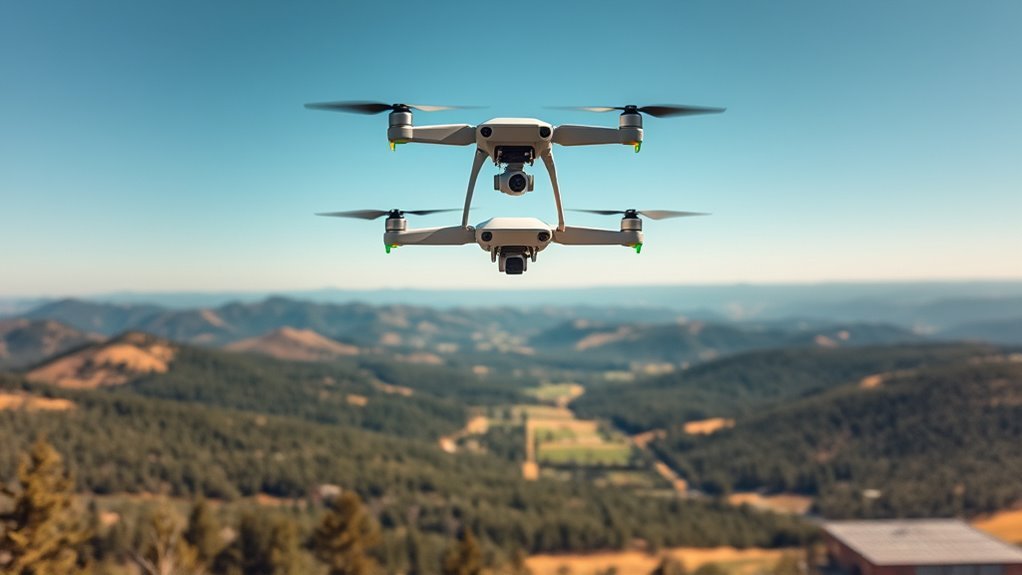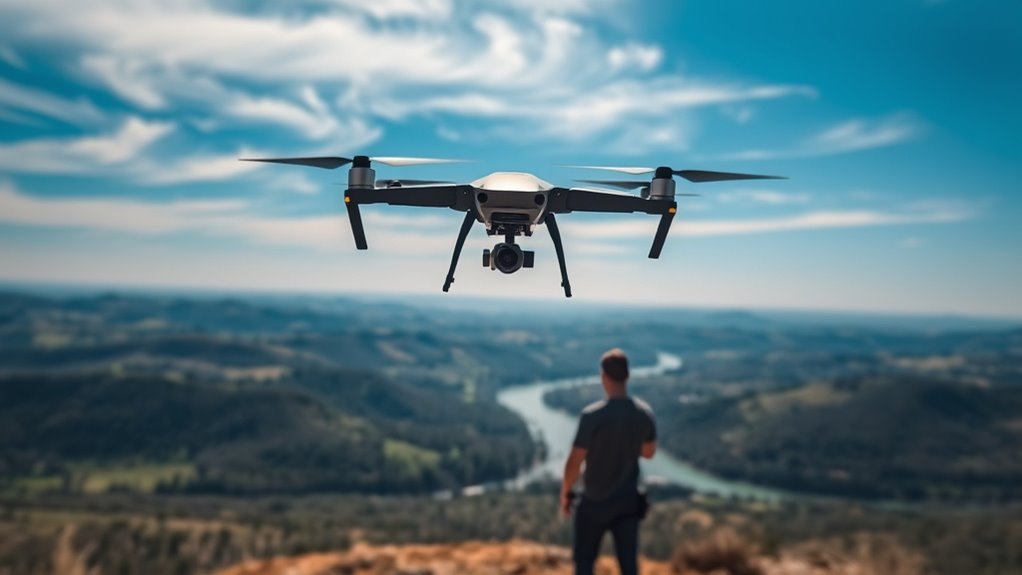You’ll find your drone’s flight distance influenced by several key factors. Battery capacity and efficient power management limit how long it stays airborne. Signal strength and controller range, affected by frequency and interference, determine control distance. Weather conditions like wind and temperature impact battery efficiency and stability. Payload weight adds strain and reduces range. Plus, regulatory flight limits restrict how far you’re allowed to fly. Understanding these elements helps optimize your drone’s performance and range, with deeper details available for further insight.
Battery Life and Power Capacity

Battery life and power capacity are fundamental determinants of a drone’s maximum flight distance. When you’re seeking freedom through extended flight, optimizing battery efficiency becomes essential. The battery’s energy density directly affects how long your drone can stay airborne before requiring a recharge. Additionally, effective power management systems regulate energy consumption, balancing propulsion and onboard electronics to maximize endurance. You’ll want to evaluate batteries with high watt-hour ratings and low internal resistance to reduce energy loss. Advanced power management integrates real-time monitoring and adaptive control algorithms, enabling your drone to conserve power during less demanding flight phases. By prioritizing battery efficiency and sophisticated power management, you enhance your drone’s range capabilities, granting you the liberty to explore farther without interruption.
Signal Strength and Controller Range

You need to evaluate the controller’s frequency bands, as they determine signal range and penetration capabilities. Interference from other devices and physical obstacles can considerably degrade signal strength, limiting your drone’s operational distance. Additionally, the quality and placement of antennas directly influence communication reliability and maximum controller range.
Controller Frequency Bands
Although several factors influence a drone’s flight distance, the controller’s frequency band plays a critical role in determining signal strength and effective range. Different controller types operate on varying frequency bands—commonly 2.4 GHz and 5.8 GHz—each with distinct frequency impact on performance. The 2.4 GHz band offers longer range and better penetration through obstacles, enhancing your freedom to fly farther. Conversely, 5.8 GHz provides higher data rates but shorter range, suitable for environments with minimal interference. Understanding these frequency characteristics helps you select a controller type that balances range and signal stability, maximizing your drone’s operational distance. Precise knowledge of frequency bands guarantees you maintain robust control, enabling extended flights without sacrificing signal integrity or risking connection loss.
Interference and Obstacles
Since interference and physical obstacles directly impact signal strength, they greatly limit your drone’s controller range. Interference sources such as Wi-Fi networks, Bluetooth devices, and other radio frequency emitters create signal noise, reducing the clarity and reach of your controller’s communication. Additionally, obstacle types like buildings, trees, and terrain features absorb or reflect radio waves, causing signal attenuation or multipath distortion. These disruptions force your drone to operate within a constrained radius to maintain reliable control and video transmission. Understanding the environment is essential; open spaces free from dense obstacle types and minimal interference sources allow you to maximize flight distance. By anticipating these factors, you can better plan your drone’s path to maintain a strong, uninterrupted connection, ensuring you experience the freedom you seek without losing contact.
Antenna Quality and Placement
Antenna quality and placement play a critical role in determining your drone’s signal strength and controller range. When you optimize antenna design, you enhance signal amplification, which directly extends the effective communication distance. High-gain antennas focus energy more efficiently, reducing signal loss and improving reception stability. Positioning antennas to avoid obstructions and align with the drone’s orientation minimizes signal attenuation caused by physical barriers or interference. You should also consider polarization matching between transmitter and receiver antennas to maximize signal integrity. Poor antenna placement or suboptimal design can drastically curtail range, limiting your drone’s freedom to explore. By investing in advanced antenna systems and strategically placing them on your controller and drone, you guarantee robust, long-distance connectivity, allowing you to push your drone’s operational boundaries safely and confidently.
Environmental Interference and Obstacles

You’ll notice that environmental factors like physical obstructions can greatly weaken your drone’s signal, reducing its effective flight distance. Weather conditions such as rain, fog, and wind also degrade communication quality and battery efficiency, limiting range. Understanding these impacts helps you plan flights that minimize interference and maximize operational distance.
Signal Obstruction Effects
When flying a drone, signal obstruction caused by environmental interference and physical obstacles can greatly reduce its effective flight distance. You need to evaluate how signal reflection from buildings or dense foliage causes multipath interference, weakening the drone’s communication link. Terrain challenges—such as hills, valleys, and dense forests—block or degrade the radio frequency signals, limiting your control range. Unlike clear line-of-sight conditions, these obstructions introduce latency and packet loss, forcing the drone to spend more energy maintaining connection or triggering failsafe protocols. To maximize freedom and range, you should plan flights with minimal signal reflection zones and avoid complex terrain that disrupts direct communication. Understanding these technical constraints helps you maintain a reliable connection, ensuring your drone flies as far as its capabilities truly allow.
Weather Impact on Range
Environmental factors extend beyond physical obstructions to include weather conditions that can greatly influence your drone’s flight distance. Understanding these variables helps you optimize flight performance and maintain control freedom.
- Temperature effects alter battery efficiency and motor performance, reducing maximum range in extreme heat or cold.
- Wind resistance increases power consumption as your drone compensates for gusts, greatly shortening flight time.
- Humidity levels affect signal propagation and can increase air density, impacting lift and control responsiveness.
- Atmospheric pressure variations influence altitude hold accuracy and overall aerodynamic efficiency, potentially limiting stable flight range.
Drone Model and Technology Specifications
Although various factors influence drone flight distance, the design and technology specifications of the drone model play a critical role. Your drone’s propulsion system, battery capacity, and weight directly impact how far it can travel. Advances in drone design, such as aerodynamic frames and lightweight materials, reduce energy consumption, extending range. Technology advancements in communication systems, like enhanced radio frequencies and signal processing algorithms, improve control reliability over longer distances. Additionally, flight controller capabilities determine how efficiently your drone manages power and navigation, optimizing endurance. When selecting a drone, consider models incorporating cutting-edge propulsion and battery technologies alongside robust communication modules. These specifications collectively enable you to push boundaries, granting greater freedom to explore expansive areas without compromising control or safety.
Weather Conditions and Their Impact
Because weather conditions directly influence drone performance, understanding their impact is essential for maximizing flight distance. You’ll want to carefully monitor wind strength and precipitation effects, as both can drastically reduce how far your drone can safely travel. Consider these four critical weather factors:
Weather conditions crucially affect drone range; monitor wind and precipitation for safer, longer flights.
- Wind Strength: Strong winds increase power consumption and destabilize flight, reducing range.
- Precipitation Effects: Rain or snow can interfere with sensors, damage electronics, and impair signal quality.
- Temperature Extremes: Cold drains battery life faster; heat may cause overheating, limiting flight time.
- Humidity: High humidity can affect aerodynamic efficiency and promote condensation inside components.
Regulatory and Legal Flight Limits
Several key regulations define how far you’re allowed to fly your drone, imposing strict limits to guarantee safety and privacy. Regulatory guidelines often mandate that drones remain within the visual line of sight (VLOS), typically restricting flight distance to a few hundred meters. These legal restrictions prevent interference with manned aircraft, protect sensitive areas, and minimize risks to people on the ground. Depending on your jurisdiction, additional constraints may include altitude ceilings, no-fly zones, and mandatory permissions for extended range operations. Ignoring these legal restrictions can lead to penalties and compromise operational safety. While you might want to push your drone’s range to its limits, understanding and complying with regulatory guidelines is essential to maintain lawful freedom in flight and avoid inadvertent violations.
Flight Mode and Autonomous Capabilities
When you select different flight modes or engage autonomous capabilities, the effective flight distance of your drone can change substantially. Autonomous navigation systems leverage GPS and sensors to execute precise flight path optimization, often extending range by minimizing unnecessary maneuvers and conserving battery life. Here are key factors to evaluate:
- Manual Mode – You control every movement, which may lead to inefficient routes and reduced range.
- GPS-Assisted Mode – Stabilizes flight, improving energy usage and extending distance.
- Waypoint Navigation – Enables predefined routes, optimizing flight paths for maximum efficiency.
- Fully Autonomous Mode – Combines real-time obstacle avoidance with flight path optimization, maximizing your drone’s operational range.
Payload Weight and Its Effect on Range
Optimizing flight modes can extend your drone’s range, but payload weight remains a significant limiting factor. When you add weight approaching or exceeding the drone’s payload capacity, you increase power consumption and reduce battery efficiency. This directly shortens your operational radius. Additionally, improper weight distribution can destabilize flight dynamics, forcing the motors to work harder to maintain control, further draining energy reserves. To maximize freedom in flight distance, you need to carefully evaluate the combined mass of your payload and guarantee it’s well balanced across the frame. Even minor imbalances can cause inefficient power use. Understanding and respecting these payload constraints allows you to push your drone farther without compromising stability or risking premature battery depletion.
Maintenance and Firmware Updates
Although payload management is essential, maintaining your drone and keeping its firmware updated are equally important to maximizing flight distance. Proper drone maintenance guarantees mechanical components operate efficiently, reducing power loss and enhancing range. Firmware updates refine flight control algorithms and improve communication protocols, which can extend operational radius.
To maintain peak flight distance, focus on these key practices:
- Regularly inspect and clean motors, propellers, and sensors to prevent wear and drag.
- Update firmware promptly to access performance enhancements and bug fixes.
- Calibrate sensors after updates or repairs to maintain accurate navigation.
- Monitor battery health and replace cells showing degradation to sustain power output.

